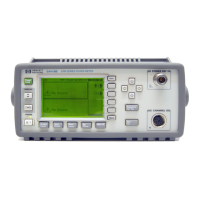prog.book : chapter1.fm 56 Mon Feb 15 09:24:37 1999
Power Meter Remote Operation
Setting Measurement Limits
1-56 HP E4418B/E4419B Programming Guide
CALCulate[1|2]:LIMit:FAIL? and the
CALCulate[1|2]:LIMit:FCOunt? for window limits.
2. Use the STATus command subsystem.
Using SENSe and CALCulate
Using SENSe to check the channel limit failures in Figure 1-6 would return
the following results:
Use the equivalent CALCulate commands for checking window limit
failures.
Note If TRIGger:DELay:AUTO is set to ON, then the number of failures
returned by SENSe:LIMit:FCOunt? or
CALCulate[1|2]:LIMit:FCOunt?will be affected by the current
filter settings.
Refer to page 9-43, page 9-44, page 3-12 and page 3-13 for further
information on using these commands.
Using STATus
You can use the STATus subsystem to generate an SRQ to interrupt your
program when a limit failure occurs. This is a more efficient method than
using SENSe or CALCulate , since you do not need to check the limit
failures after every power measurement.
Refer to “Status Reporting”, on page 1-71 and “STATus Subsystem”, on
page 10-1 for further information.
Configuring the TTL Outputs
The TTL Outputs on the rear panel Rmt I/O port can be used to determine
when a predefined limit in either, or both, windows has been exceeded.
SENSe:LIMit:FAIL? Returns 1 if there has been 1 or
more limit failures or 0 if there
have been no limit failures. In
this case 1 is returned.
SENSe:LIMit:FCOunt? Returns the total number of
limit failures, in this case 2.

